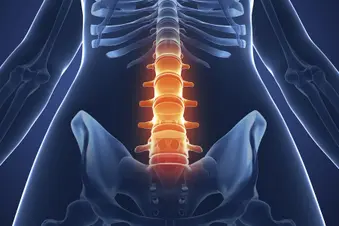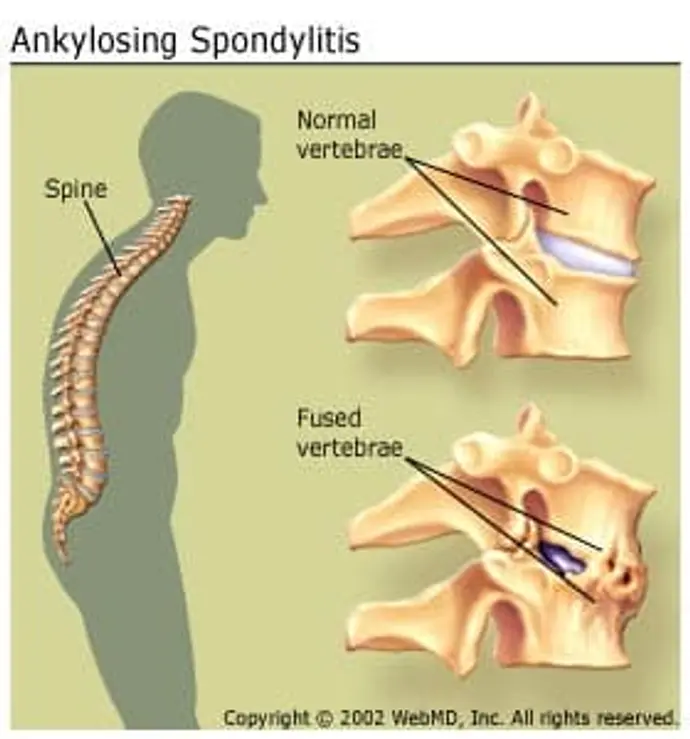
What Is Ankylosing Spondylitis?
Ankylosing spondylitis (AS) is a rare type of arthritis that causes pain and stiffness in your spine. This lifelong condition, also known as Bechterew disease, usually starts in your lower back. It can spread up to your neck or damage joints in other parts of your body.
"Ankylosis" means fused bones or other hard tissue. "Spondylitis" means inflammation in your spinal bones, or vertebrae. Severe cases can leave your spine hunched.
There’s no cure for AS. But medication and exercise can ease pain and help keep your back strong.

Ankylosing Spondylitis Symptoms
AS often starts in your sacroiliac joints, where your spine connects to your pelvis. It can affect places where your tendons and ligaments attach to bones. It can even cause your vertebrae to fuse together.
You might have pain or stiffness in your:
- Lower back
- Buttocks
- Shoulders
- Hands
- Rib cage
- Hips
- Thighs
- Feet
- Heels
You might notice:
- Pain that’s worse in the morning or after sitting for a long time
- A rigid spine that curves forward
- Tiredness
- Swelling in your joints
- Trouble taking deep breaths
Symptoms can differ from person to person. Your condition also may change quicker or slower than someone else’s.
Ankylosing Spondylitis Complications
AS can cause pain and inflammation throughout your body, including in your:
- Spine. In rare cases, your vertebrae may become weak, making them more likely to fracture or break. Damaged vertebrae can press on or irritate a group of nerves in the bottom of your spinal cord called the cauda equina. You might have trouble controlling your bowels or bladder, sexual problems, or a loss of reflexes.
- Eyes. About 40% of people with AS have an eye problem called uveitis. It’s a kind of eye inflammation that's painful and can blur your vision and make you sensitive to bright light. If you have uveitis, your doctor might check for AS even if you don’t have any other symptoms.
- Heart valve. Rarely, AS can enlarge your aorta, the largest artery in your body. This can change the shape of your aortic valve, allowing blood to leak back into your heart. Your heart won’t pump as well, which can leave you tired and short of breath.
People with AS are also more likely to get certain types of cancers. They include bone and prostate cancers in men and colon cancer in women, as well as blood-related cancers in both sexes.
Ankylosing Spondylitis Causes
Researchers aren’t sure what triggers AS, but they think it’s tied to your genes. Most people with AS have a gene that makes a protein called HLA-B27. Doctors think it tells your immune system to attack some common bacteria in your body and sets off AS symptoms.
Ankylosing Spondylitis Risk Factors
Certain things that you can’t control might raise your risk of AS:
- Sex. Men are more likely than women to have AS, and it strikes them earlier and harder. Women tend to have a milder form of AS called non-radiographic axial spondyloarthritis.
- Age. AS often starts in your teens and young adulthood. About 80% of cases begin before the person turns 30, and 95% by age 45.
Ankylosing Spondylitis Diagnosis
AS can be tough to spot because so many people have back pain, its main symptom. A diagnosis may be even trickier for women because the condition is much more common in men.
There’s also no single test to confirm AS. Your doctor may rely on your symptoms, a physical exam, and blood tests.
You also might have an X-ray or an MRI. But this doesn’t always help, because joint damage may not show up right away on imaging tests.
Ankylosing Spondylitis Treatments
Medications help some people. But staying active is one of the keys to managing AS.
Exercise. The less you sit or lie down, the better you’ll feel. Exercise helps you stand straighter and keeps your spine limber. Staying active may even banish your pain without medication.
Physical therapy. You'll need to practice good posture, learn how to stretch tight muscles and keep your spine stable, and use other techniques that can lower your pain. You can do them at home, but most people benefit more from working with a professional physical therapist or with a group.
Medication
Prescription nonsteroidal anti-inflammatory drugs (NSAIDs) like indomethacin (Indocin) help most people who have AS. But they can lead to stomach bleeding, heart problems, and other side effects.
If your condition is severe, your doctor may have you try stronger medications like biologics. These are made with things like proteins. But they may cause serious side effects, including infections.
Ankylosing Spondylitis Lifestyle and Home Remedies
Some things you do every day can help you feel better.
- Make time to exercise every day, even a few minutes at a time. Working out in water helps a lot of people who have AS.
- Keep a healthy weight so your joints aren’t under as much stress. A diet high in omega-3 fatty acids might help. Watch for patterns if you think certain foods might trigger changes in how you feel.
- Don’t smoke. People who smoke tobacco often have symptoms that get worse as they get older.
- Manage stress with things like massage, yoga, meditation, and counseling.
- Apply heat to stiff joints and tight muscles, and use cold on inflamed areas.
Show Sources
SOURCES:
Genetic and Rare Diseases Information Center (National Institutes of Health): “Ankylosing Spondylitis.”
Arthritis Foundation: “What Is Ankylosing Spondylitis.”
University of Maryland Medical Center: “A Patient’s Guide to Ankylosing Spondylitis.”
Spondylitis Association of America: “Overview of Ankylosing Spondylitis,” “Sex Differences in Ankylosing Spondylitis,” “Does the Microbiome Cause Ankylosing Spondylitis?” “Treatment of Ankylosing Spondylitis and Related Diseases.”
American College of Rheumatology (rheumatology.org): “Spondyloarthritis.”
Harvard Health Blog: “FDA strengthens warnings that NSAIDs increase heart attack and stroke risk.”
Rachel Caspi, senior investigator, National Eye Institute.
Kidshealth.org: “A to Z: Spondylitis, Ankylosing.”
UpToDate: “Clinical manifestations of axial spondyloarthritis (ankylosing spondylitis and nonradiographic axial spondyloarthritis) in adults.”
Brigham and Women’s Hospital: “Standard of Care: Ankylosing Spondylitis.”
Journal of Clinical Medicine Research (Canada): “Cardiac Involvement in Ankylosing Spondylitis.”
Genetics Home Reference: “Ankylosing spondylitis.”
National Institute of Arthritis and Musculoskeletal and Skin Diseases: “Ankylosing Spondylitis.”
Mayo Clinic: “Ankylosing spondylitis.”
Merck Manual Consumer Version: “Compression of the Spinal Cord.”
Johns Hopkins Arthritis Center: “Ankylosing Spondylitis.”